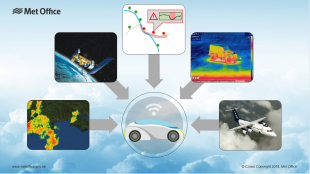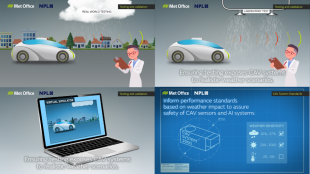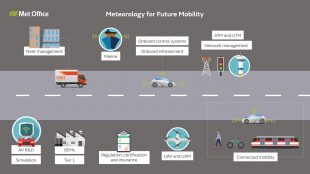The Met Office was founded in 1854 and has pioneered the science of meteorology and its application. They provide critical weather services and world-leading climate science, which helps you make better decisions to stay safe and thrive. This includes working with the transport sector, a partnership that has been in place for many years.
Keeping abreast of the future and the role of connected autonomous vehicles (CAVs), the Met Office wanted to understand what the requirements were from those vehicles for weather and climate information. We hear from Patrick Sachon, (Group Leader - Energy, Industry and Infrastructure), who was involved in setting up a business development project to try and understand what the Met Office could do to help autonomous vehicles operate safely and efficiently in the future. This blog provides another clear example of how a government organisation can use its knowledge and expertise for another purpose, and for a new and emerging requirement.
Historically, our focus has been on providing ‘route-based’ forecasting and warning services related to the state of the road surface. These forecasts help make sure that roads are kept clear of ice and snow, while drivers are aware of other weather-related hazards, such as heavy rainfall; all actions to keep traffic flowing safely.
We strive to deliver extraordinary impact from our data and science, creating increased social and economic benefits. So, in addition to keeping the UK’s roads moving and users safe, we set about exploring how our support for road transport would be likely to change in the future as vehicles became more connected and moved towards higher, or perhaps even complete, levels of autonomy.
To investigate this, we set up a business development project to explore the potentially burgeoning market for CAVs. We engaged a wide range of stakeholders across government, industry and academia. The feedback we received helped us to understand that CAVs would use a wide range of automated decision systems to make decisions that rely heavily on sensors, cameras, laser systems and radars. These sensors were likely to be affected by a different and wider range of meteorological parameters than just the state of the road surface, which was previously the only factor to consider when conducting ‘route-based’ forecasting.

The weather challenge for CAVs is more complex than the considerations for traditional vehicles. In addition to knowing about the state of the road, these vehicles need a wider meteorological situational awareness, a great deal of which is related to how the sensors on the vehicles will perform.
The overriding factor for CAVs is how the sensors would perform in different weather conditions. It’s important to note that snow, ice and precipitation not only affect driving conditions, but they can also interfere with on-board sensors such as lasers and cameras. So, we needed to understand when could these sensors be relied upon: when would they work and when would they not work? This set of considerations determine the Operating Design Domain (ODD) for the sensors and the CAV. The engineering effort behind the development of CAVs is centred on expanding the ODD to cover as many operating conditions as possible.
We realised that we could repurpose the science we had developed on how weather affects systems and sensors for defence and aviation customers, as well as how it affects weather observing systems. This could then help us understand how sensors being developed for CAVs would work in different weather conditions. Factors such as how sensors would work in different types of precipitation or, how intense precipitation really is inside convective storms (i.e. strong thunderstorms), must be modelled realistically when sensors and CAVs are developed and tested.
It was timely therefore, when we were approached by the National Physical Laboratory (NPL) as they undertook a project with Connected Places Catapult (the UK's innovation accelerator for cities, transport, and places) on the assurance of CAV sensors. It became quickly apparent that the combination of our roles, could be brought together to provide a traceable framework for assuring CAV performance in all weathers.

Testing phases that the Met Office and the NPL were involved in.
As a result, our two organisations have been working on behalf of the Centre for Connected and Autonomous Vehicles (CCAV) for the last year on the usability and reliability of sensors in different weather conditions. This has included industry engagement and involved defining the ‘ecosystem’ of lab measurements, real-world (external) testbeds and large environmental chambers (that can generate rain and fog), alongside developing virtual testing in a virtual environment, with synthetic data and simulation (as shown by the above diagram).
With NPL, we hope to demonstrate the external sensor testbed in the coming months, generating unique datasets to prove the value for the UK CAV industry and UK plc, on how testbeds for CAV sensors can be developed.
This work acts as a clear example of how a government organisation has used its knowledge that was developed for one purpose, for a different, new and emerging requirement. There are still challenges in harnessing this experience - not only in the CAV industry but also in Unmanned Aviation and for Marine Autonomous Surface Ships. This includes how the work is funded, how the emerging new transport capabilities will collect and ingest data, how regulation of the new platforms works and how all of this is implemented within the wider transport industry.

Connected autonomous transport is likely to revolutionise the transport sectors, from Research & Development, through regulation, on air, land and at sea, and in how these vehicles are owned and used. This diagram picks out some of the major developments and drivers.
The approach so far has demonstrated that through working closely with industry, it is possible to understand emerging trends and challenges that in turn generate potential new uses for existing knowledge assets.
For more information on the work we are doing around CAVs, please contact Patrick Sachon via the Met Office website.
Leave a comment